![]()
![]()
![]()
Use LEFT and RIGHT arrow keys to navigate between flashcards;
Use UP and DOWN arrow keys to flip the card;
H to show hint;
A reads text to speech;
54 Cards in this Set
- Front
- Back
|
What is fourier transform
|
The 1D Fourier transform is a mathematical procedure that allows a signal to be decomposed into its frequency components.
|
|
|
What 3 parameters are needed to describe a sine wave with fourier transform
|
amplitude
frequency phase |
|
|
How is frequency determine
|
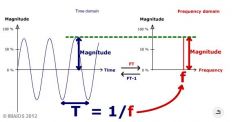
|
|
|
How is magnitude determined
|
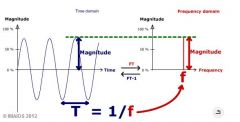
|
|
|
What is the fourier transform
|
The Fourier transform is a mathematical procedure that decomposes a signal into a sum of sine waves of different frequencies, phases and amplitude.
|
|
|
By knowing frequency, amplitude and phase of each sine wave, is possible to reconstruct the signal (inverse Fourier transform).
|
yes
|
|
|
What tends to have a higher amplitude low or high frequency
|
low frequency
|
|
|
What is the right to left direction in MR
|
X
|
|
|
What is changing when moving from right to left
|
the rows
|
|
|
What type of frequency have the greatest change in intensity
|
low spatial frequencies
|
|
|
Do high spatial frequencies have low amplitude
|
yes
|
|
|
What describes the basic shape of the image
|
low spatial frequencies
|
|
|
What must be done to create a 2d image
|
2D fourier transform
|
|
|
How is a 2D fourier transform created
|
first it is done in one direction(X ...right to left)
|
|
|
What is the frequency domain
|
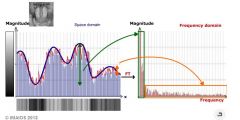
|
|
|
Is there a frequency domain in the X and Y direction
|

yes
|
|
|
Look and see how low spatial frequencies have the greatest change in intensity.
|
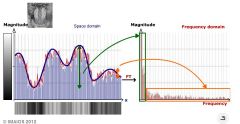
Note that the big waves are low frequency and have the biggest change in intensity
|
|
|
Note how the high spatial frequency have lower amplitudes
|
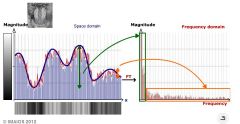
small little waves (redline)
|
|
|
What describes the general shape of an MR image
|
General shape of the image is described by low spatial frequencies: this is also true with MRI images
|
|
|
What is the 2nd step of the 2D fourier transform
|
The second step of 2D Fourier transform is a second 1D Fourier transform in the orthogonal direction (column by column, Oy), performed on the result of the first one
|
|
|
What is the image that can be created as a result of a fourier transform in the X and Y direction
|
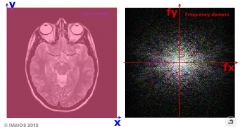
|
|
|
What do the horizontal and vertical axis correspond to
|
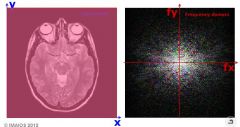
Horizontal and vertical axis correspond to horizontal and vertical spatial frequencies
|
|
|
What determines the pixel intensity
|
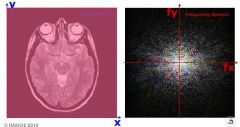
Pixel intensity corresponds to the amplitude (or magnitude) of frequency component
|
|
|
What does the color correspond to
|
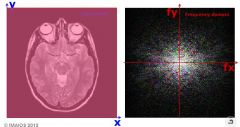
Color corresponds to the phase of frequency component
|
|
|
What are the 3 things encoded in a fourier plane
|

Horizontal and vertical axis correspond to horizontal and vertical spatial frequencies
Pixel intensity corresponds to the amplitude (or magnitude) of frequency component Color corresponds to the phase of frequency component. |
|
|
What is this called
|
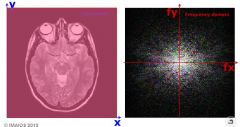
fourier plane
|
|
|
What are the 3 components of a fourier plane
|

|
|
|
where is the MR signal stored
|
The readout MR signal is stored in K-space which is equivalent to a Fourier plane.
|
|
|
How do you go from a K-space to an image
|
To go from a k-space data to an image requires using a 2D inverse Fourier Transform
|
|
|
How do you go from a K-space to an image
|
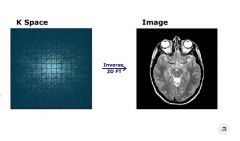
|
|
|
What is required to go from K space to image formation
|
To go from a k-space data to an image requires using a 2D inverse Fourier Transform.
|
|
|
Are frequency-encoding and phase-encoding done so that data is spatially encoded by differences in frequency and phase, amenable to analysis by Fourier transform
|
yes
|
|
|
In k-space what is the horizontal spatial frequency replaced by
|
Kx
|
|
|
In K-space what is the vertical spacial frequency replaced by
|
Ky coordinates
|
|
|
What does the K-space coordinate system look like
|
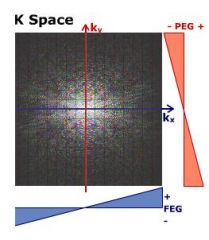
|
|
|
Where does the K-space start to fill in following the 90° RF pulse + Slice-selection gradient :
|
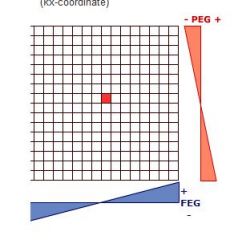
location at origin (center) of k-space
|
|
|
Where does the K space fill if there is negative and strong phase encoding gradient
|

moves to the lower bound of k-spac
|
|
|
What line is filled in following a 180 RF pulse and the slice selection gradient
|
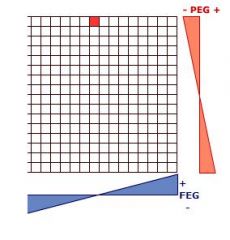
moves to the opposite location
|
|
|
Repetition for each line with increasing phase-encoding gradient strength (negative to positive intensity).
|
The amount of gradient phase change between adjacent line is constant. This results in a sequential (line by line) filling of k-space from top to bottom.
|
|
|
What determines the K space location in the Kx and Ky coordinate system
|
The k-space location (kx and ky coordinates) of data is governed by the accumulated effect of gradient events and excitation pulses
|
|
|
Where is the begining of the sequence in K space
|
The initial RF excitation pulse (with the slice-selection gradient) is the beginning of the sequence: location is at the center of k-space.
|
|
|
What governs the next movement in K-space
|
the phase encoding gradient
|
|
|
What determines what direction K space will go in the Y direction
|
The greater the net strength of the phase-encoding gradient (or the longer the gradient is on), the farther from the k-space origin the data belong, in the upper direction if the gradient is positive or in the lower direction if the gradient is negative. As the duration of phase-encoding gradient is most often constant, the strength of the phase-encoding gradient governs the location on the vertical axis (ky-coordinate).
|
|
|
What if there is a strong positive phase encoding gradient
|
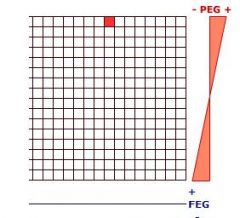
It will move up
|
|
|
What happens if there is a negative phase encoding gradient
|

it will move down
|
|
|
What determines how far from the K space origin it will go
2 |
The greater the net strength of the phase-encoding gradient (or the longer the gradient is on), the farther from the k-space origin the data belong,
|
|
|
After the gradient moves up or down (Y-direction bc of phase encoding gradient), where does it go now
|
right or left depending on the frequency encoding gradient
|
|
|
If the phase encoding gradient was negative (previous example) and there is a strong positive frequency encoding gradient which direction doese K space fill
|
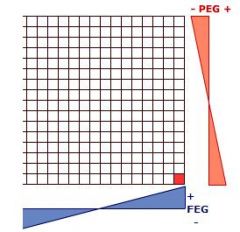
to the right
|
|
|
If the phase encoding gradient was negative (previous example) and there is a NEGATIVE frequency encoding gradient which direction doese K space fill
|

to the left
|
|
|
What determines the direction of K-space filling during the frequency encoding gradient
|
The longer the frequency-encoding gradient is on (or the greater the net strength of the gradient is), the farther from the k-space origin the data belong, in the right direction if the gradient is positive or in the left direction if the gradient is negative. As the strength of the frequency-encoding gradient is most often constant, the duration of the frequency-encoding gradient governs the location on the horizontal axis (kx-coordinate)
|
|
|
What happens following the 180 RF pulse
|
if fills on the opposite side of K space
|
|
|
What is the order of a standard spin echo sequence
|
90 pulse
phase encoding frequency encoding 180 degree pulse |
|
|
What is the order of filling in K space
|
90 pulse -center
phase encoding - up or down frequency encoding - L or R 180 pulse flip to other side |
|
|
How does phase encoding gradient strength dictate how the k-space is filled ing
|
Repetition for each line with increasing phase-encoding gradient strength (negative to positive intensity). The amount of gradient phase change between adjacent line is constant. This results in a sequential (line by line) filling of k-space from top to bottom.
|

